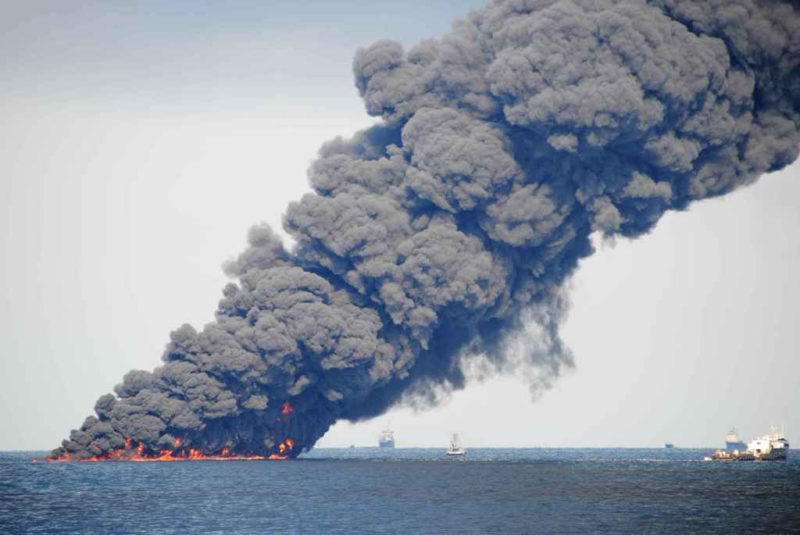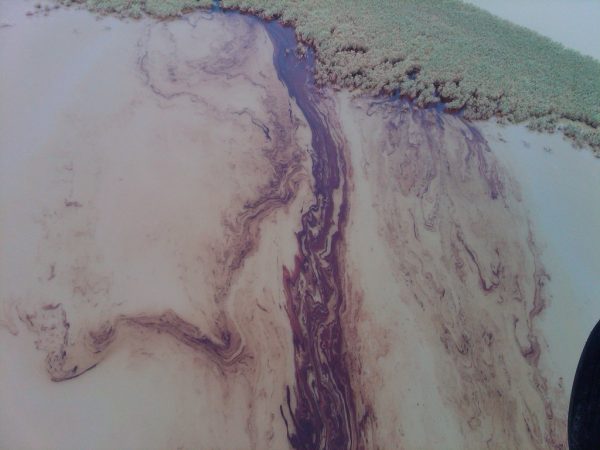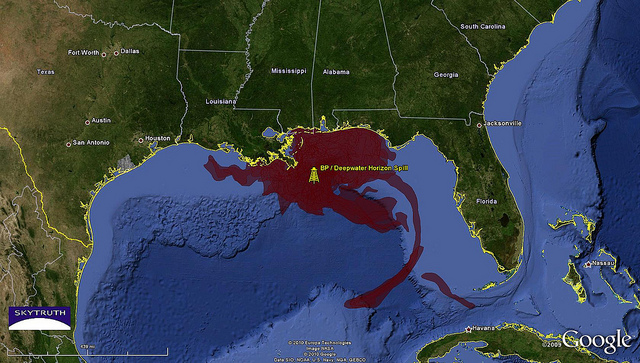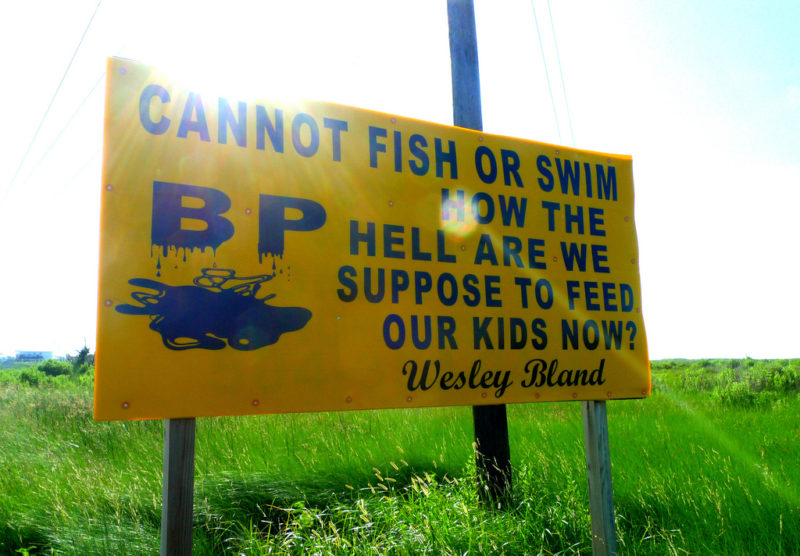Editor’s Note: The following series “Something Fishy” is a week-long series curated by Rosalind Kidwell as part of the Digital Research Internship Program in partnership with ViaNolaVie. The DRI Program is a Newcomb Insitute technology initiative for undergraduate students combining technology skillsets, feminist leadership, and the digital humanities.
An integral part of life in South Louisiana is our extensive aquatic life. Fish permeate New Orleans culture, whether they’re from the Gulf or a nearby Bayou, whether they’re on or off our plates. This collection of articles for “Something Fishy,” explores the importance of these creatures in the nearby area. The Gulf is not only home to a multitude of aquatic life, but also to countless drilling rigs. Though monetarily profitable, these drilling practices come at a steep cost to the surrounding ecosystem. This article was originally published on Media Nola on May 6, 2014.
Oil has helped shape history by becoming an essential resource for the past and the present, without it the world may be incredibly different. It is one of the most profitable and economically positive influences for the United States. The oil industry has been booming in the Gulf South since the late 1900’s. The industry was born with the Spindletop geyser in southeast Texas and migrated across the Gulf South and the country. As oil influenced the economy, oil companies attempted to find the most efficient and safest ways to extract oil from the Earth. However, the process of harvesting oil can have harmful effects on the environment and economy if companies do not focus on making sure rigs are operating safely. This has been seen in the past from some of the worst oil spills. such as the Lake View Gusher and Exxon Valdez incidents. The most recent and devastating oil spill recorded in United States history is the accident with British Petroleum called Deep Water Horizon.

The spill from afar. Photo by Ideum via Flickr.
Oil spills have been recorded since the early 1900’s. The amount of oil spills are increasing as demand and oil production increase. Oil spills have always been a problem, but not a major concern. The absence of concern was due to the lack of knowledge and technology available to study the effects on the environment. After years of studying past incidents people have learned more about the negative effects major oil spills have on the environment. The world’s largest oil spill was known as the Lake View Gusher. It took place in Kern County, California on May 14, 1910, releasing 378 million gallons of crude oil. The second largest oil spill is known as the Gulf War Oil Spill. It occurred in 1990 during the Gulf War when Iraqi invaded Kuwait. Iraqi forces intentionally released 252-336 million gallons of oil into the Persian Gulf. The major oil spills in the United States took place in California, Massachusetts, Alaska, and the Gulf South region. More than half of them occurred in the Gulf South region due to the increase of oil production in this area. However, the most notorious oil spills in United States history are the Exxon Valdez oil tanker and the Deep Water Horizon drilling rig. The Exxon Valdez incident occurred in the Prince William Sound off the coast of Alaska. This oil tanker collided with a reef on December 15, 1976, spilling over 10 million gallons of oil.
The Deep Water Horizon Oil Spill catastrophe occurred on April 20, 2010, and is considered the United States’ largest and the world’s most environmentally destructive offshore oil spill in history. The disaster took place in the Gulf of Mexico’s Mississippi Canyon Block 252, about 42 miles off the Louisiana coast in 5,000 feet of water. The spill took place when a blow-out preventer (BOP) failed on the British Petroleum oil rig, known as Deep Water Horizon. This caused an uncontrollable release of crude oil into the sea. Eleven people died during the BOP failure, and two days later the oil rig collapsed and fell to the sea floor causing irreparable damage. It was not until three months later on July 15, 2010, that the well was capped, and on September 19 it was finally permanently sealed. This failure caused an estimate of 4.9 million barrels (205.8 million gallons) of crude oil to be released in the Gulf of Mexico. The federal government sent all available resources to help with the disaster. Some of the federal agencies that responded were the Department of Homeland Security (DHS), Environmental Protection Agency (EPA), Department of Defense (DOD), and the National Oceanic and Atmospheric Administration (NOAA). State and private agencies also responded to the disaster.
The BP oil spill affected all Louisiana, Alabama, Mississippi, and Florida. On May 6, 2010, Breton National Wildlife Refuge, located in southeast Louisiana, was the first place to have oil washed ashore. Almost a month later on June 1, the oil reached the shore of Gulf Islands National Seashore. By late June, Gulfport, Mississippi, and Gulf Breeze, Florida also had oil wash ashore (Paul Murphy. “Barataria Bay still struggling 4 years after BP oil spill.” The Advertiser. April 10, 2014). Due to this, it is estimated that 665 miles of coastline became contaminated.

A marsh destroyed by the BP oil spill. Photo provided by Louisiana GOHSEP
The Deep Water Horizon oil spill not only affected the animals and plants of the marsh and ocean, but it also affected the Gulf South economy as far as the seafood industry goes (Kimberly Amadeo. “When, Where and Economic Effects.” BP Gulf Oil Spill Facts (December 19, 2013). Accessed April 15, 2014). The projected loss of profit for the seafood industry is in the billions of dollars over a 10 year period. The fact that fishermen and shrimpers could not get their catches from the Gulf of Mexico caused an increase in imported seafood, creating more competition with local seafood in the future. This hurt the local economy since it revolved around the two major industries most affected by the spill, seafood and oil, a central part of the South’s culture. As a result, the oil spill affected almost every aspect of life in the Gulf South in some way.
Besides being the world’s largest offshore oil spill, the BP oil spill was the biggest ecological disaster the U.S. has ever seen. One way to see the effect of the oil spill on the environment is through water samples. Water samples taken in June 2010 in Grand Isle, Louisiana show that the levels of toxic oil byproducts like carcinogenic polycyclic aromatic hydrocarbons (PAHs) have multiplied by 40. There were also 1.8 million gallons of toxic dispersants released in the water to dissolve the oil.
In terms of the effect of the spill on sea life, these results were also easily seen. Bottlenose dolphins and other sea mammals that surface for air were also affected by the oil skim. The majority of the oil sank to the bottom of the seafloor or created plums (pockets of oil) midway between the surface and ocean floor. In fact, less than ten percent of the oil released made it to the surface. These oil plums created a considerable issue for the marine life on the sea floor (Lacey McCormick. “40,000-Pound Tar Mat Reminds Us the Oil Spill is Not Over.” National Wildlife Federation. Posted on June 27, 2013). Similarly, the oil that sank to the bottom killed unknown amounts of coral, natural habitats for marine life. Contaminated water caused by dispersants also killed the eggs and larva of shrimp, crab, grouper, blue fin tuna, snapper, mackerel, and swordfish. Because of this, 78,000 square miles in the Gulf of Mexico were closed to fishing (Committee on Energy and Commerce, THE BP OIL SPILL: ACCOUNTING FOR THE SPILLED OIL AND ENSURING THESAFETY OF SEAFOOD FROM THE GULF (Washington: U.S. Government Printing Office, 2013) 1-106).

Deepwater Horizon oil Spill-Cumulative Oil Slick Footprint. Photo provided by Sky Truth
For many birds, mainly pelicans, the instant effects of the BP oil spill were astronomical (“How Does the BP Oil Spill Impact Wildlife and Habitat?” National Wildlife Federation. N.p., n.d. Web. 16 Apr. 2014). This is primarily because marshes and mangroves that help to protect the Gulf South from storms were also killed by the oil. As a result, birds such as pelicans, gulls, plovers, terns, and other shore birds that live in the marshes became covered with oil. Pelicans scattered along the shore on beaches were covered in the thick crude, making cleanup of them extremely difficult. While many died, others were spared through facilities and programs to help wildlife along the Gulf South. Results from lab tests also show traces of oil in some of these dead birds, which may have been caused by ingesting other contaminated sea life (Haeyoun Park, Xaquin G.V., Graham Roberts, Erin Aigner, Shan Carter and Kevin Quealy, “The Oil Spill’s Effects on Wildlife,” New York Times, August 16, 2010).
Shortly following the BP oil spill, the National Oceanic and Atmospheric Administration (NOAA) went to the Gulf South to witness the effects the oil spill had on the southern states’ aquatic life. They wanted to conduct a study on how the oil and the chemical dispersants used to dissipate the oil affected marine life in the Gulf of Mexico over time (Naomi Klein, “After The Spill,” The Nation Vol. 292 (January 1, 2011)). The organization looked at the most common marine species such as pelicans, shrimp, plankton, certain fish, and dolphins. Their results showed most marine life was either unaffected or did not show signs of damage.
While there were casualties, the NOAA proved that it was not to the extent that was originally predicted. Long term effects nearly four years later have included nearly 17 percent of the dolphin population along the Southeastern Louisiana coast to be significantly ill and most likely perish (“Study Shows Gulf Dolphins in Poor Health following Deepwater Horizon Oil Spill,” NOAA Office of Response and Restoration, December 18, 2013). Sea turtles are being found dead in the gulf waters and coral reefs are disappearing. These effects are all from oil being ingested, trapping the animals to the point of death, or depriving them of oxygen. These are only the first effects to show up within the last few years (National Academy of Sciences. “Assessing impacts of the Deepwater Horizon oil spill in the Gulf of Mexico.” ScienceDaily). More destructive events may appear as time goes on. The one comfort provided by the NOAA’s study is that while many species were affected by the oil spill, it was not to the apocalyptic extent originally predicted.
Several scholars have actively contributed to and proposed plans for the clean up of the BP oil spill. In Ray Mabus’ article, “America’s Gulf Coast: A Long Term Recovery Plan after the Deep Water Horizon Oil Spill,” he discusses a long-term recovery plan for the Gulf South (Ray Mabus, “America’s Gulf Coast: A Long Term Recovery Plan after the Deepwater Horizon oil spill,” (September 2010)). He contemplates the idea of different organizations and councils in order to prevent future disasters from occurring in the future. While more regulations are necessary, Mabus’ article takes the approach of punishing the entire oil industry for one company’s failure to check safety systems. His idea, along with others, contributed to the moratorium that would follow the disaster. President Obama, in the weeks after the BP oil spill revisited the idea of a moratorium. On May 27 of 2010, the President put into effect several rules and regulations upon the oil industry which included everything from depth regulations to completely halting rigs (Elizabeth Beard, Maureen Hannan, Phillip Hayward, “After The Spill,” Vol. 45 (November 2010);United States. Congress. House. The BP oil spill: accounting for the spilled oil and ensuring the safety of seafood from the Gulf: hearing before the Subcommittee on Energy and Environment of the Committee on Energy and Commerce, House of Representatives, One Hundred Eleventh Congress, second session, August 19, 2010, (2013)). Major stipulations included: drilling in Alaska would be stopped until 2011, drilling deeper than 500 feet was prohibited, and drilling on 33 rigs in the Gulf would be stopped immediately pending safety checks. These were only the major rules put into effect, but the industry was not pleased with moratorium and criticized it heavily (Research Priorities for Assessing Health Effects From the Gulf of Mexico Oil Spill: A Letter Report. Washington, D.C.: National Academy Press, 2010). With the spill lasting almost three entire months, millions of gallons of oil devastated the Gulf Coast, and many media outlets, spectators, and journalists had the opportunity to provide their own thoughts and facts about the oil spill.

A sign protesting abject conditions. Photo by Wolfram Burner.
With this major environmental and economic disaster in the past, what is in the future for BP and the oil spill in general? We, as outdoor’s men, believe the wildlife, both land and sea, will recover from the devastating effects of the oil spill. The industry has had more regulations placed upon it, and the oil economy of Louisiana is still booming. The cleanup process has since withered away yet the effects are not noticeable on the surface. Down 5000 feet on the seafloor, however, a bare landscape appears in what should be a thriving forest. (Katie Valentine. “Four years After The Deepwater Horizon Oil Spill, The Gulf Is Still Suffering.” Climate Progress. Posted on April 20, 2014). Oil coats the seafloor in nearly a four inch layer (Hellen Kennedy. “Deepwater Horizon Oil Spill Oil Rig Explosion April 2010.” YouTube, 2:50. Posted May 2010). Life no longer exists in this area, only five miles away from the rig. No clues as to the severity of the damage farther away from the site have been brought forth. With this event now in the past, residents of the Gulf South can move on from this terrible disaster, but not without the tragic memory of all the life lost (Bruce Barcott. “Forlorn In The Bayou.” Louisiana’s wetlands are resilient and have bounced back before. But no one knows how long this recovery will take Vol. 218 (October 2010)). The Deep Water Horizon oil spill of 2010 will be remembered for decades to come (Michelle Nijhuis. “Crude Awakening.” Scientists are just beginning to grasp how profoundly oil has devastated the Gulf of Mexico Vol. 41 (September/ 2010)).
 NOLAbeings
Multimedia artist Claire Bangser created NOLAbeings as a portrait-based story project that marries...
NOLAbeings
Multimedia artist Claire Bangser created NOLAbeings as a portrait-based story project that marries...
 Data corner: Adobe Suite (create a PDF, social media graphic, presentation, edit a photo and video
Data corner is where you go to work with analytics and top tech skills. It takes on everything from PERL and SQL to Canva and Sprout Social.
Data corner: Adobe Suite (create a PDF, social media graphic, presentation, edit a photo and video
Data corner is where you go to work with analytics and top tech skills. It takes on everything from PERL and SQL to Canva and Sprout Social.
